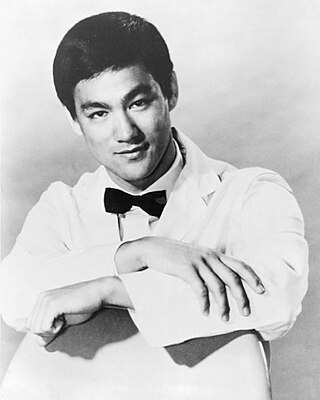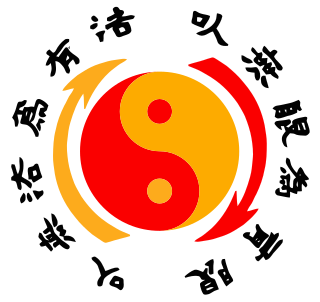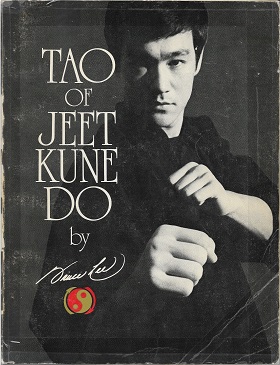
Martial arts are codified systems and traditions of combat practiced for a number of reasons such as self-defence; military and law enforcement applications; competition; physical, mental, and spiritual development; entertainment; and the preservation of a nation's intangible cultural heritage.

Bruce Lee was a Hong Kong-American martial artist and actor. He was the founder of Jeet Kune Do, a hybrid martial arts philosophy drawing from different combat disciplines. Credited with helping popularize martial arts films in the 1970s, Lee is considered by some commentators and martial artists to be the most influential martial artist of all time and a pop culture icon of the 20th century, who bridged the gap between East and West. He is credited with promoting Hong Kong action cinema and helping to change the way Chinese people were presented in American films.

Jeet Kune Do is a hybrid martial art conceived and practiced by martial artist Bruce Lee. It was formed from Lee's experiences in unarmed fighting and self-defense—as well as eclectic, Zen Buddhist and Taoist philosophies—as a new school of martial arts thought.

Dan Inosanto is a Filipino-American martial arts instructor and actor. Inosanto holds Instructor or black belt level ranks in several martial arts. He has studied traditional Okinawan karate, Judo, Jujutsu, Kenpo, Shoot wrestling, Systema, Filipino martial arts, and Jeet Kune Do. He was one of three people who were appointed to teach at one of the three Jun Fan Gung Fu institutes under Bruce Lee, the other two being Taky Kimura and James Yimm Lee. After Bruce Lee's death, Inosanto became the principal spokesperson and historian for Jeet Kune Do.
The following outline is provided as an overview of and topical guide to martial arts:
Ted Wong was a martial arts practitioner best known for studying under Bruce Lee.
There are at least eight distinct lineages of the martial art Wing Chun. These are mostly little-known outside of China, and each has its own history of origin. In the West, Wing Chun's history has become a mix of fact and fiction due to the impacts of early secrecy and modern marketing. Additionally, there are competing genealogies within the same branch or about the same individual teacher.

Tao of Jeet Kune Do is a book expressing Bruce Lee's martial arts philosophy and viewpoints, published posthumously. The project for this book began in 1970 when Bruce Lee suffered a back injury during one of his practice sessions. During this time he could not train in martial arts. He was ordered by his doctors to wear a back brace for 6 months in order to recover from his injury. This was a very tiring and dispiriting time for Lee who was always very physically active.

Footwork is a martial arts and combat sports term for the general usage of the legs and feet in stand-up fighting. Footwork involves keeping balance, closing or furthering the distance, controlling spatial positioning, and/or creating additional momentum for strikes.
Tim Tackett is a martial arts instructor and author from Redlands, California who runs a non-profit group dedicated to preserving Bruce Lee's art of Jeet Kune Do.
Jesse Raymond Glover was an African-American martial artist. He was Bruce Lee's first student. He met Lee in 1959, as they both attended Edison Technical College and practiced judo with Lee. Glover was a psychology major and a champion judoka. The character Jerome Sprout in the 1993 film Dragon: The Bruce Lee Story was based on Glover.

Bruce Lee's Fighting Method is a book of volumes covering Bruce Lee's martial arts abilities of the Jeet Kune Do movement. The book is available as a single hardcover volume or a series of four paperback volumes. The text describes Bruce Lee's Kung Fu fighting techniques, philosophy and training methods. This book was originally written in 1966 by Bruce Lee. However, Lee decided not to publish this work as he feared that instructors would use the fighting knowledge in this text to promote themselves. In 1978, after Bruce Lee's death, his widow Linda Lee Cadwell decided to make available the information on her husband's work. Lee's death changed the perspective of releasing the information that Bruce Lee himself had vacillated about. The book was published with the help of Mitoshi Uyehara. Uyehara was the founder and owner of Black Belt Magazine. During the early years of the publication, Uyehara served as the publisher. Bruce Lee contributed many articles to the publication during the 1960s and a friendship ensued between the two men. Uyehara, a martial artist in his own right, was a key personage in arranging Lee's material for publication.
The Bruce Lee Library is composed of books written by or about Bruce Lee (1940-1973), famous Hongkongese and American martial artist, philosopher, author, instructor of martial arts, actor, filmmaker and screenwriter.
John R. Little is a writer and bodybuilding advocate. A native of Canada, Little is a writer in the fields of martial arts, bodybuilding and physical conditioning.
Martial artist and actor Bruce Lee has been subject to extensive media coverage.

James Yimm Lee was an American martial arts pioneer, teacher, author, and publisher. James Lee is known for being a mentor, teacher and friend of Bruce Lee.

Richard Bustillo was an American martial arts instructor from Hawaii who was a student of the late Bruce Lee and an authority on Jeet Kune Do Concepts and Filipino Martial Arts.
Takauki "Taky" Kimura was an American martial artist who was best known as being one of Bruce Lee's top students and closest friends - and a certified instructor in Jun Fan Gung Fu, personally certified by Bruce Lee himself. Kimura was also the best man at Lee's wedding, and one of six pallbearers during his funeral, the others including Dan Inosanto, Steve McQueen, James Coburn, Peter Chin and Robert Lee, Bruce's brother.
James W. DeMile was an American martial artist, psychologist and author. He was among the first group of students of Bruce Lee, whom he met in 1959, as they both attended Edison Technical School. In 1963, DeMile appeared in Lee's only book, The Philosophical Art of Self Defense. He was an inductee in the AMAA Who's Who in the Martial Arts Hall of Fame and Black Belt Magazine Hall of Fame.

Salem Assli was a French-American martial artist, instructor, and researcher best known as the first B.F. Savate instructor in the US. He also continued the development of martial arts on five continents and was Head of the French association of Jeet Kune Do and Filipino Kali.










